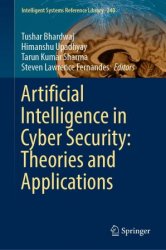 Название: Artificial Intelligence in Cyber Security: Theories and Applications
Название: Artificial Intelligence in Cyber Security: Theories and ApplicationsАвтор: Tushar Bhardwaj, Himanshu Upadhyay, Tarun Kumar Sharma
Издательство: Springer
Год: 2023
Страниц: 144
Язык: английский
Формат: pdf (true), epub
Размер: 13.1 MB
This book highlights the applications and theory of Artificial Intelligence in the domain of cybersecurity.
The book proposes new approaches and ideas to present applications of innovative approaches in real-time environments. In the past few decades, there has been an exponential rise in the application of Artificial Intelligence (AI) technologies (such as Deep Learning, Machine Learning, blockchain) for solving complex and intricate problems arising in the domain of cybersecurity. The versatility of these techniques has made them a favorite among scientists and researchers working in diverse areas. This book serves as a reference for young scholars, researchers, and industry professionals working in the field of Artificial Intelligence and Cybersecurity.
The book comprises of 9 Chapters. In Chap. 1, the authors provide a comprehensive and systematic literature review on the use of ML in cloud security and its applications and techniques to prevent security issues on cloud computing. Chapter 2 introduces the heterogeneous model for WSNs and discusses the clustering techniques for HWSN networks. Also authors have conducted an exhaustive survey of the heterogeneous network in wireless sensor models and discussed about the top priority being granted to productive energy usage. Chapter 3 compares various sentimental analysis techniques to classify the restaurant reviews as positive or negative sentiments to find the most suitable one to use to achieve maximum accuracy in terms of classification between positive or negative reviews and also automated the approach. Chapter 4 presents many applications of Machine Learning and cyber security that are currently employed in various industries.
Chapter 5 presents various challenges that arise when Machine Learning is integrated with cybersecurity. Chapter 6 discusses the need for detecting anomalies in thermal power plant data for monitoring and maintaining the conditions of these power stations and discusses various artificial intelligence (AI) techniques to detect sensor data anomalies in different components of a thermal power plant. Chapter 7 analyzes Deep Learning (DL) models, formed with three hidden layers and three different optimizer functions for intrusion detection in the data traffic. In Chap. 8, the authors propose a machine learning-based framework with various supervised learning algorithms such as Random Forest, Support Vector Machine, and Decision Trees. The authors perform the hyper-parameter optimization of these algorithms using sci-kit-learn machine learning frameworks. In Chap. 9, the authors address the problem of analyzing fraudulent credit card transactions. Explicitly, we propose a deep learning-based framework with various unsupervised learning algorithms. The authors have performed the hyperparameter optimization of these algorithms using Sci-kit-learn Machine Learning frameworks and popular Deep Learning framework TensorFlow.
We hope that the effort will be found informative and interesting to those who are keen to learn on technologies that address to the challenges of the exponentially growing information in the core and allied fields of cyber security. This book will be beneficial to the young scholars and researchers working in the allied domain. We are thankful to the authors of the chapters for their valuable contribution to the conference and for bringing forth significant research and literature across the field of cyber security. Offering valuable insights into cyber security for the young scholars, researchers, academicians and industrialists, this book will inspire further research in this dynamic field.
Скачать Artificial Intelligence in Cyber Security: Theories and Applications